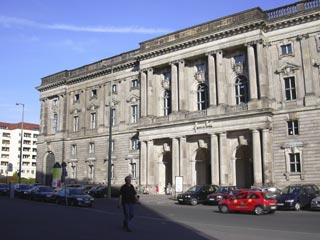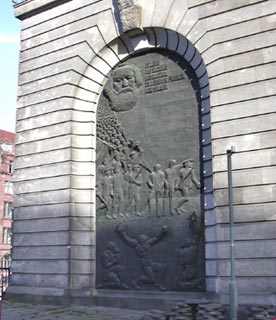












![]() The new Marstall (stable), once royal and imperial horse stable, has been a new purpose after extensive reconstruction.
The new Marstall (stable), once royal and imperial horse stable, has been a new purpose after extensive reconstruction.
Today, students of the Academy of Music 'Hanns Eisler' Berlin, are being tutored where once up to 350 horses and several king's coaches were stabled. Here, they find excellent conditions in several practise studios and 3 concert halls with ingenious acoustic.
![]() The former horse boxes at the Spree-wing were recreated into altogether over 100 practice rooms for the music students. The planning took 15 years and the rebuilding 6 years.
The former horse boxes at the Spree-wing were recreated into altogether over 100 practice rooms for the music students. The planning took 15 years and the rebuilding 6 years.
The Krönungskutschen (crowing coaches) Hall was rebuilt into an attractive 300 seat concert hall with the very best acoustic qualities. So-called 'Excellent-Concerts' take place here regularly under the patronage of the Honourable Senator HfM Daniel Barenboim.
Also the newly founded Jazz-Institut Berlin (JIB), arisen from the jazz sections of the Academy for Music 'Hanns Eisler' Berlin and the University of Arts Berlin, has found here practise rooms until they were able to move into their own building in 2006.
After year-long rebuilding the Marstall has become once again a public focus with its representative historical building and its cultural usage.
![]() Address:
Address:
Hochschule für Musik" Hanns Eisler" Berlin
Schloßplatz 7
10178 Berlin
Main Building: Charlottenstraße 55
10117 Berlin![]() +49(30) 90 269-700
+49(30) 90 269-700
Fax +49(30) 90 269-701
Internet: www.hfm-berlin.de![]() Transport Links:
Transport Links: ![]() S5, S7, S75, S9
S5, S7, S75, S9![]() U2, U5, U8 Alexanderplatz
U2, U5, U8 Alexanderplatz![]() M4, M5, M6
M4, M5, M6![]() 100, 200, 148, TXL
100, 200, 148, TXL
![]() The new Marstall on the Schloßplatz in Berlin-Mitte - the new-baroque building of the former royal Marstall, was built 1897-1901 after plans by Ernst von Ihne directly at the Spree, opposite the Stadtschloss. Apart from town houses, a part of the Old Marstall, which stems from the year 1669, were built over.
The new Marstall on the Schloßplatz in Berlin-Mitte - the new-baroque building of the former royal Marstall, was built 1897-1901 after plans by Ernst von Ihne directly at the Spree, opposite the Stadtschloss. Apart from town houses, a part of the Old Marstall, which stems from the year 1669, were built over.
The building, under monumental protection, has been more simply recreated after the 2nd World War. Preserved are the richly decorated gables and the 'Rossebändiger' (horse tamer) on the Spree side.

Two bronze tablets by the sculptor Gerhard Rommel at the Marstall's entrance, document its moving history. The Marstall was, during the November revolution 1918, seat of the Volksmarine division and the revolutionary committee of the workers and sailors. The historic relief, unveiled in 1988, still at GDR times, remind of the fight of the red sailors.
The premise was used during the GDR times as city archive, senate library and as an administration wing for the Palast der Republik.